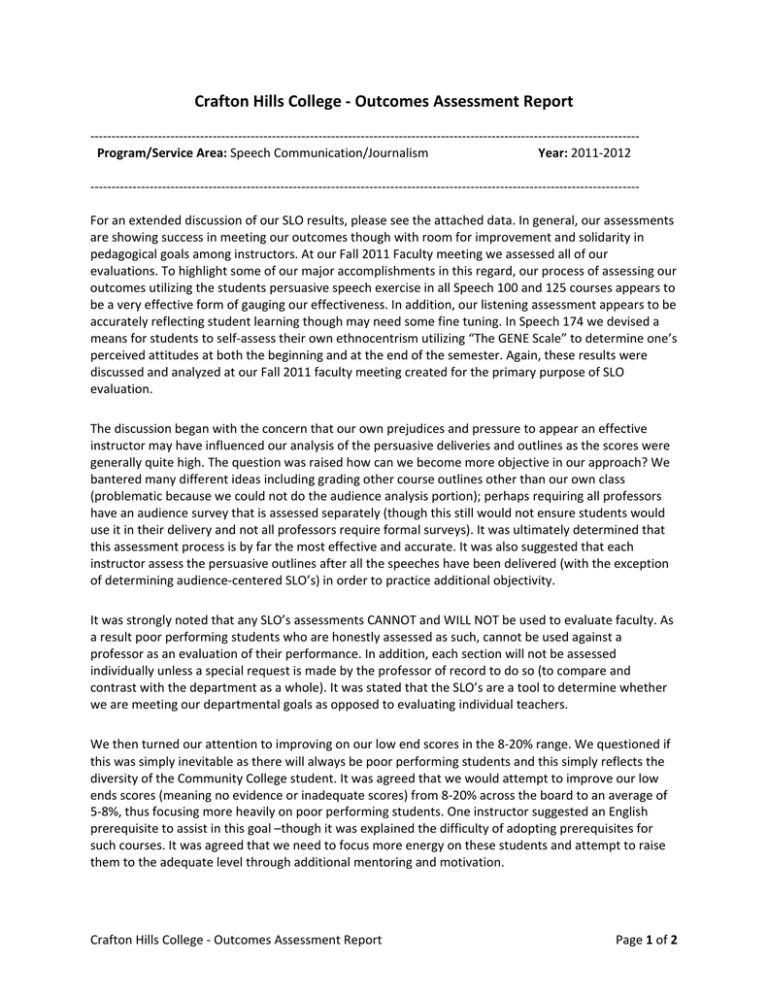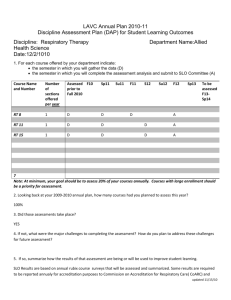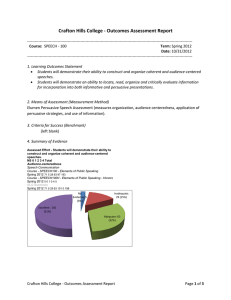Crafton Hills College ‐ Outcomes Assessment Report
advertisement

Crafton Hills College ‐ Outcomes Assessment Report ‐‐‐‐‐‐‐‐‐‐‐‐‐‐‐‐‐‐‐‐‐‐‐‐‐‐‐‐‐‐‐‐‐‐‐‐‐‐‐‐‐‐‐‐‐‐‐‐‐‐‐‐‐‐‐‐‐‐‐‐‐‐‐‐‐‐‐‐‐‐‐‐‐‐‐‐‐‐‐‐‐‐‐‐‐‐‐‐‐‐‐‐‐‐‐‐‐‐‐‐‐‐‐‐‐‐‐‐‐‐‐‐‐‐‐‐‐‐‐‐‐‐‐‐‐‐‐‐‐‐ Program/Service Area: Speech Communication/Journalism Year: 2011‐2012 ‐‐‐‐‐‐‐‐‐‐‐‐‐‐‐‐‐‐‐‐‐‐‐‐‐‐‐‐‐‐‐‐‐‐‐‐‐‐‐‐‐‐‐‐‐‐‐‐‐‐‐‐‐‐‐‐‐‐‐‐‐‐‐‐‐‐‐‐‐‐‐‐‐‐‐‐‐‐‐‐‐‐‐‐‐‐‐‐‐‐‐‐‐‐‐‐‐‐‐‐‐‐‐‐‐‐‐‐‐‐‐‐‐‐‐‐‐‐‐‐‐‐‐‐‐‐‐‐‐‐ For an extended discussion of our SLO results, please see the attached data. In general, our assessments are showing success in meeting our outcomes though with room for improvement and solidarity in pedagogical goals among instructors. At our Fall 2011 Faculty meeting we assessed all of our evaluations. To highlight some of our major accomplishments in this regard, our process of assessing our outcomes utilizing the students persuasive speech exercise in all Speech 100 and 125 courses appears to be a very effective form of gauging our effectiveness. In addition, our listening assessment appears to be accurately reflecting student learning though may need some fine tuning. In Speech 174 we devised a means for students to self‐assess their own ethnocentrism utilizing “The GENE Scale” to determine one’s perceived attitudes at both the beginning and at the end of the semester. Again, these results were discussed and analyzed at our Fall 2011 faculty meeting created for the primary purpose of SLO evaluation. The discussion began with the concern that our own prejudices and pressure to appear an effective instructor may have influenced our analysis of the persuasive deliveries and outlines as the scores were generally quite high. The question was raised how can we become more objective in our approach? We bantered many different ideas including grading other course outlines other than our own class (problematic because we could not do the audience analysis portion); perhaps requiring all professors have an audience survey that is assessed separately (though this still would not ensure students would use it in their delivery and not all professors require formal surveys). It was ultimately determined that this assessment process is by far the most effective and accurate. It was also suggested that each instructor assess the persuasive outlines after all the speeches have been delivered (with the exception of determining audience‐centered SLO’s) in order to practice additional objectivity. It was strongly noted that any SLO’s assessments CANNOT and WILL NOT be used to evaluate faculty. As a result poor performing students who are honestly assessed as such, cannot be used against a professor as an evaluation of their performance. In addition, each section will not be assessed individually unless a special request is made by the professor of record to do so (to compare and contrast with the department as a whole). It was stated that the SLO’s are a tool to determine whether we are meeting our departmental goals as opposed to evaluating individual teachers. We then turned our attention to improving on our low end scores in the 8‐20% range. We questioned if this was simply inevitable as there will always be poor performing students and this simply reflects the diversity of the Community College student. It was agreed that we would attempt to improve our low ends scores (meaning no evidence or inadequate scores) from 8‐20% across the board to an average of 5‐8%, thus focusing more heavily on poor performing students. One instructor suggested an English prerequisite to assist in this goal –though it was explained the difficulty of adopting prerequisites for such courses. It was agreed that we need to focus more energy on these students and attempt to raise them to the adequate level through additional mentoring and motivation. Crafton Hills College ‐ Outcomes Assessment Report Page 1 of 2 We completed our discussion on these evaluation results in terms of improving our Audience‐ Centeredness scores (our lowest scoring area). In addition to stressing this area more in our classes, setting aside more class time for this, and requiring surveys, we agreed this needs to made an emphasis in our classes from the first day to the last day of the course. In addition, our listening assessment appears to be accurately reflecting student learning though may need some fine tuning. Again, these results and the effectiveness of the assessment will be discussed at said meeting. In short, the diversity assessment administered in Spring 2010 does not appear to provide us with the date we need and will be discarded as we introduce an entirely new self‐assessment. Our retention and pass rates have essentially remained the same at 88.6% and 76.5% respectively (compared with 90 and 75% the previous year). Our FTEF ratio remains very low and continues to drop, down to .26 from .31 a year previous. There continues to be only one full‐time professor in the department making the assessment process very difficult with a high number of part‐time faculty who generally do not assist in these departmental processes. When contrasted with our WSCH number of 3,670 our current ratio is 509.79, up from 434.25; this is incredibly high for the Speech Communication Program; if most classes are capped at 30, then even with a 100 percent retention, the WSCH/FTEF should at highest be 450. Our faculty are overextending themselves to accommodate as many students as possible, which is very difficult in a performance related program. Our FTES is up to 122.35 from 115.8 a year previous. In short, our classes are overextended with no room for growth under the existing support structures. Crafton Hills College ‐ Outcomes Assessment Report Page 2 of 2

